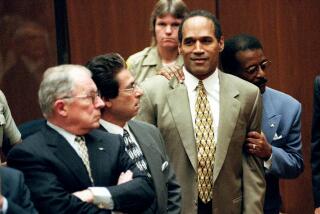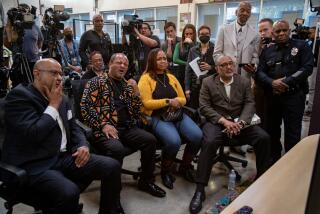Doctor Says Fall, Not Baton Blow, Left Sand Grain in King’s Face
A single grain of sand removed from Rodney G. King’s face months after his beating was seized upon by the defense in the trial of four police officers Tuesday to show that King’s injuries were caused by a fall.
Dr. Dallas Long III, an emergency room physician from Irvine who did not treat King, said he examined medical records and found that on May 15, 1991, King had some scar tissue removed from his face.
During the procedure, he said, a particle of sand was found embedded in a scar.
“How could a piece of sand become embedded in the flesh?” asked attorney Michael P. Stone.
“It has to be driven in with some force,” said Long. “It’s associated with falls on some sort on gravel.”
Asked for his opinion about King’s massive facial fractures, he said the majority were “most consistent with a fall against a flat surface.”
“Does the existence of an embedded piece of sand or gravel enhance that opinion?” asked Stone.
“Oh yes, it enhances it, sure,” said the witness.
However, Long said that one cut on the right side of King’s scalp was probably caused by a baton blow.
Long was called as a witness for Stone’s client, Officer Laurence M. Powell, accused of inflicting the most baton blows on King during a videotaped beating March 3, 1991.
Stone was attempting to blunt the damaging testimony of California Highway Patrol Officer Melanie Singer, who wept on the witness stand as she remembered Powell bashing King in the head repeatedly with his baton.
She described King cowering under the blows with his hands over his face, as Powell struck him on the knuckles.
Stone showed Long a picture of King’s hands after the beating. The doctor said he could detect no injuries.
Powell is on trial in federal court along with Sgt. Stacey C. Koon and officers Theodore J. Briseno and Timothy E. Wind. They are charged with violating King’s civil rights in the beating that followed an auto chase.
Prosecutors objected to Long’s expert testimony, saying he lacked the qualifications to give opinions in the field of injury causation. Long, who now works in an outpatient clinic, said his specialty was emergency medicine but his “hobby” is studying the causes of injuries. U.S. District Judge John G. Davies allowed the testimony.
Stone showed Long photos taken of King’s face shortly after the beating. Pointing to a scrape on King’s right cheek, he asked the doctor’s opinion of its cause.
“I don’t believe that is a baton injury delivered by an adult male,” Long said.
He was the first medical witness in six weeks of testimony to say that King’s injuries resulted from a fall. Doctors who treated King and a biomechanics expert testified for the prosecution that King’s facial bones were shattered by blows from a baton. They said it was impossible to receive such injuries in a fall.
Long gave similar testimony last year in the officers’ state trial in Simi Valley where they were acquitted on all but one count, setting off deadly riots in Los Angeles.
Stone, who is fond of courtroom demonstrations, had Wind’s lawyer, Paul DePasquale, get down on the floor while Stone used a baton to indicate where on King’s face Singer said she saw baton blows.
“Is there anything in the medical evidence that suggests a blow like this occurred?” asked Stone.
“No,” said Long.
Singer testified Monday: “There is no doubt in my mind that he (Powell) struck him in the face. I will never forget it until the day I die.”
Head blows are forbidden by the Los Angeles Police Department because they can be deadly.
More to Read
Sign up for Essential California
The most important California stories and recommendations in your inbox every morning.
You may occasionally receive promotional content from the Los Angeles Times.










